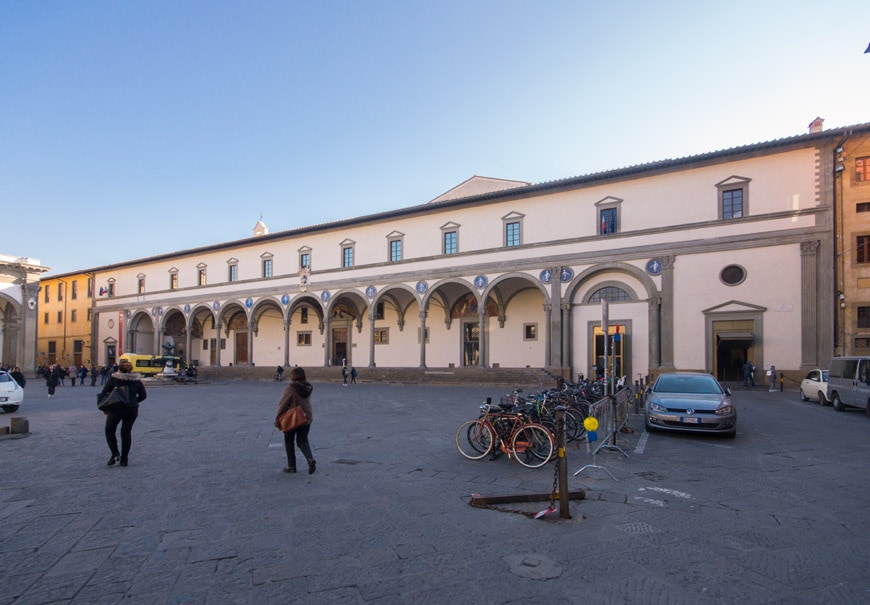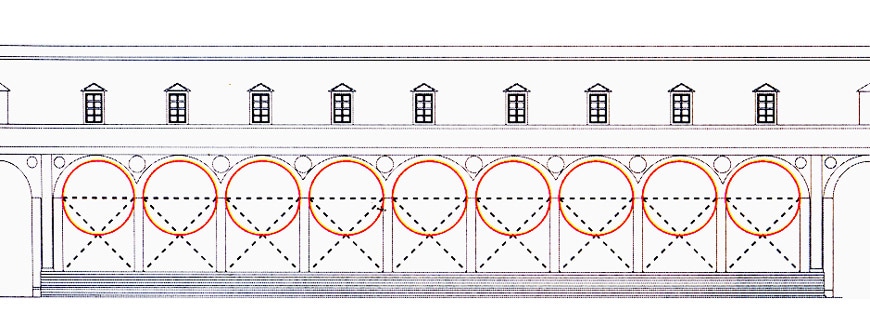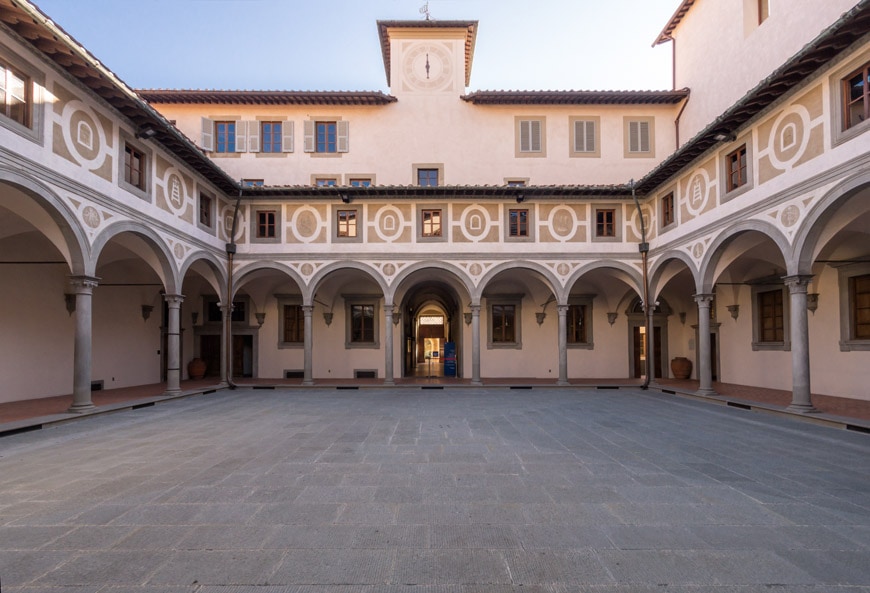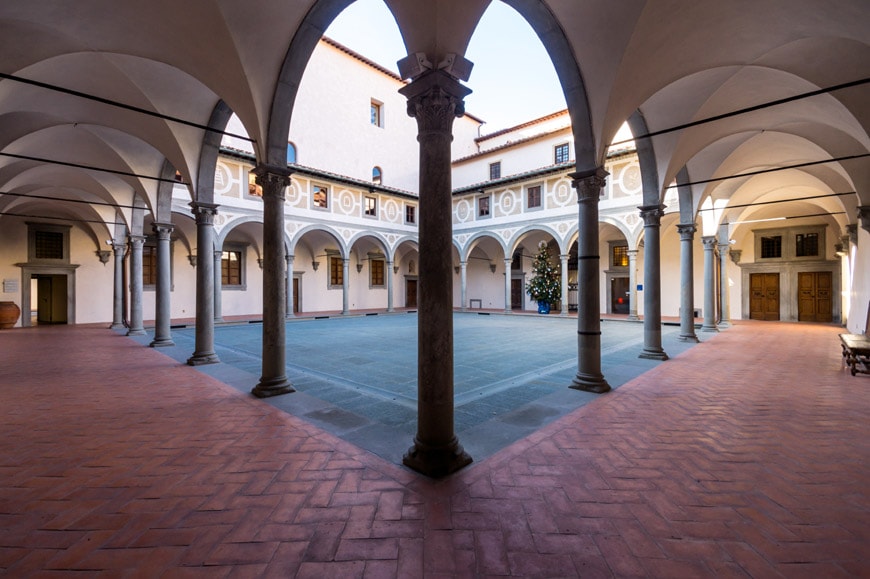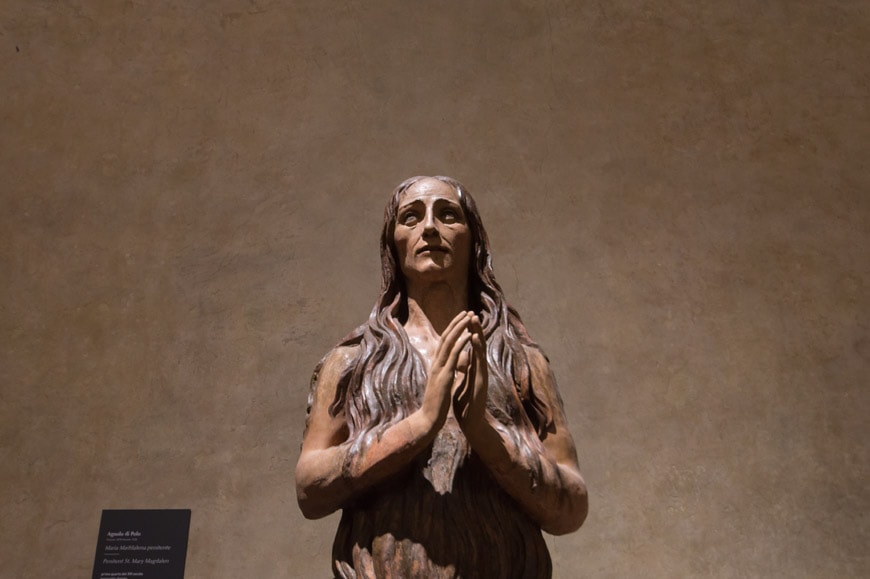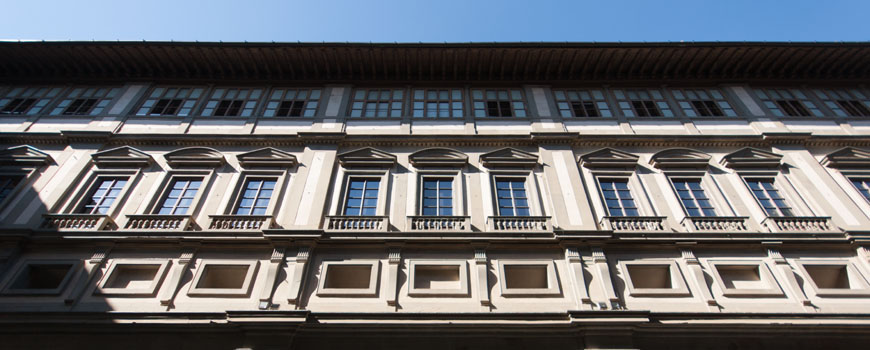Museo degli Innocenti, Florence
Toscana, Italy
Phone: +39 055 20371
Website: https://www.istitutodeglinnocenti.it/

The Museo degli Innocenti in Florence is a museum of art and history located in the world-famous Ospedale degli Innocenti building designed by Filippo Brunelleschi in the early 15th century; today, the museum is part of the Istituto degli Innocenti charity.
Brunelleschi’s building
The Ospedale degli Innocenti (Hospital of the Innocents) is a former orphanage whose nucleus was built between 1419 and 1427 after a design by Filippo Brunelleschi.
Brunelleschi’s building comprises the main facade on Piazza della Santissima Annunziata and two wings, containing a church and the children’s residence, which flank a large square cloister known as Cortile degli Uomini (Men’s Courtyard).
Widely regarded as one of the greatest masterpieces of the Renaissance, the building features many elements that will subsequently become archetypes of Italian Renaissance architecture, such as its elegant portico – based on a precise module corresponding to ten Florentine braccia, about 19 feet -, the use of round arches, the geometrically exact combination of gray stone (Pietra Serena) and white stucco, and its references to classic Roman architecture.
With the Ospedale, Brunelleschi somewhat established the basis of “modern” architecture, namely an architecture based on precise mathematical-geometrical rules, technical innovations (such as the use of sail vaults built without centering), on a strict relationship between form, materials, and structure and, at large, on a design rigor which leaves nothing to chance.
“(Filippo Brunelleschi designed) the house and the loggia of the Innocents, whose vaulting was made without framing, a method followed by everyone today. It is said that Filippo, summoned to Milan to design a fortress for Duke Filippo Maria (Visconti), delegated the construction of this building of the Innocents to Francesco della Luna, a close friend of him. This Francesco added an ornamental frame to an architrave, which is a mistake according to the rules of architecture. When Filippo came back and reprimanded him for such a thing, he replied that he had copied that ornament from the ancient temple of San Giovanni (the Baptistery of San Giovanni in Florence). “There is only one error in that building, and you followed it”, Filippo said”.
from Giorgio Vasari, Lives of the Most Excellent Painters, Sculptors, and Architects, 1568
The original building was expanded between 1439 and 1440 by architect Francesco della Luna, who added a floor to the facade and designed a second cloister, the Cortile delle Donne (Women’s Courtyard). The facade was decorated in 1487 with a series of terracotta tondos with cupids by Andrea della Robbia.
The Istituto degli Innocenti was the first public institution in Europe specifically aimed to accommodate orphans and abandoned infants; today, the organization, along with running the museum and a historical archive, is a charity devoted to children’s care and education.
Hospital of the Innocents, Florence, (architects Filippo Brunelleschi and Francesco della Luna), facade on Piazza della Santissima Annunziata; photo © Inexhibit
Geometrical scheme of the facade portico of the Hospital of the Innocents by Filippo Brunelleschi
The renovation project
The Museo degli Innocenti reopened in 2016, after the completion of an ambitious restoration and renovation project by Ipostudio Architetti. The renovation comprised a complete redesign of the museum’s interior spaces, a new entrance, a revised circulation system including a new staircase and an elevator, the opening of the basement to the public, new conference and service spaces, the creation of a panoramic cafe in the rooftop loggia, and innovative exhibition systems and fit-outs for the museum’s galleries.
The exhibition system of the main art gallery is particularly interesting. It consists of an array of hinged panels made in fiberglass and aluminum, each 3 meters wide and high, which support most of the artwork on view there and can be arranged in different configurations to flexibly adapt to future changes in the exhibition layout. The panels are fixed to a counter-wall which also conceals technical and artificial lighting systems.
For the historical exhibition, Ipostudio conceived some ingenious solutions, such as a large curved filing cabinet that contains small objects and ornaments mothers left with the infants they were abandoning to help them identify them in the future.
The new literary cafe is an interesting addition as well. The cafe is located on the top level, in the so-called Verone, a large veranda once used to air out clothes and as a playground for the children – enclosed by glazing panels that can be removed in spring and summer transforming it into an open-air roof terrace bar.
“Art Itinerary”, main gallery, installation view; photo © Inexhibit
Permanent exhibitions
The museum features three main permanent exhibitions, called History itinerary, Architecture itinerary, and Art itinerary.
The architectural exhibition features a visit to Brunelleschi’s building, Francesco della Luna’s cloister, and the Verone portico-terrace.
The historical exhibition – through artifacts, artworks, memorabilia, documents, and multimedia exhibits – presents the 600-year-long history of the Istituto degli Innocenti, with a special focus on the personal stories and everyday life of the children who were living in the orphanage, as well as on the historical and social context in which the institution was created and developed.
The Art exhibition features about sixty artworks donated to the institution over time.
Pieces on view include exquisite masterpieces of Italian Renaissance art – such as the Madonna with Child and Angel by Botticelli, the Virgin and Child Enthroned with Saints by Piero di Cosimo, and the Adoration of the Magi by Domenico Ghirlandaio, all paintings, and the Madonna with Child sculpture by Luca della Robbia.
Overall, the visit is intriguing and provides visitors with different and unusual points of view on Florentine history and art. Highly recommended.
Images
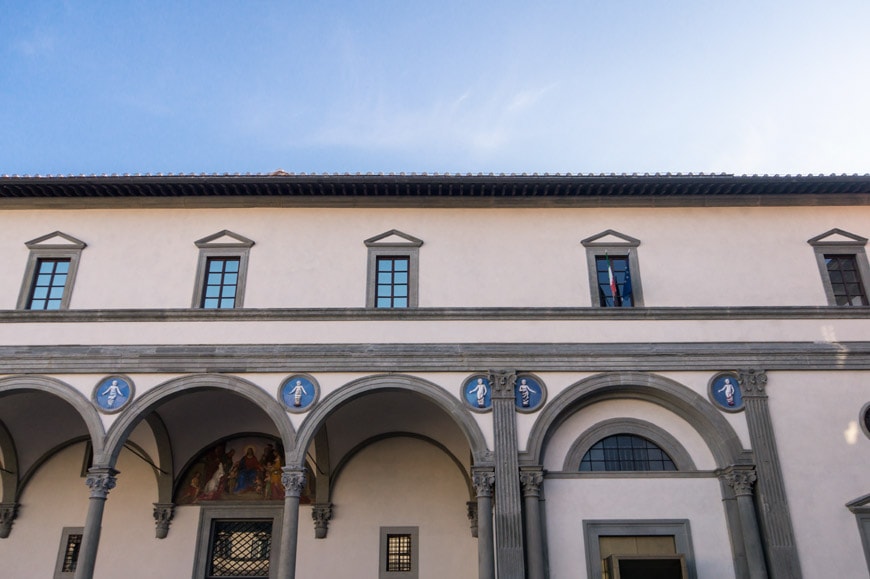
Istituto degli Innocenti, Hospital of the Innocents, Florence, detail of the main facade designed by Filippo Brunelleschi (portico) and Francesco della Luna (upper floor), the terracotta tondos with cupids are by Andrea della Robbia; photo © Inexhibit
The “Men’s Courtyard” designed by Filippo Brunelleschi; photos © Inexhibit
The “Women’s Courtyard” designed by Francesco della Luna; photo © Inexhibit
Museo degli Innocenti, historical exhibition, installations views; photos © Inexhibit

The historical exhibition, Marco della Robbia also known as Fra Mattia, Adoring Madonna, and Saint Joseph, ca. 1500, painted terracotta; photo © Inexhibit

The historical exhibition, sculptures of a swaddled infant (the emblem of the Hospital of the Innocents) by various artists from Florence; 16th-19th century; photo © Inexhibit
The curved wooden filing cabinet that contains the ornaments of various abandoned children, and one of the interactive exhibits of the historical exhibition; photo © Inexhibit
Art exhibition, general view; foreground: Giovanni del Biondo, Annunciation with St. Nicholas and St. Antony, 1372-1376, tempera on board; photo © Inexhibit
Art exhibition; foreground: workshop of Domenico Ghirlandaio, Madonna with Child and seraphs, last quarter of the 15th century, fresco painting; photo © Inexhibit
Art exhibition, center: Luca della Robbia, Madonna with Child, ca. 1445-1450, glazed terracotta; photo © Inexhibit

Sandro Botticelli (Alessandro Filipepi), Madonna with Child and Angel, ca. 1465, tempera on board; photo © Inexhibit
Agnolo di Polo, Penitent Magdalene (detail), early-16th century, painted terracotta; photo © Inexhibit

Art exhibition; left to right: Piero di Cosimo, Virgin and Child Enthroned with Saints, 1493, tempera on panel; Domenico Ghirlandaio, Adoration of the Magi, 1488-1489, tempera and oil on panel; Neri di Bicci, Coronation of the Virgin with Saints, 1460-1461, tempera on panel; photo © Inexhibit
View of the new staircase, part of the renovation project designed by Ipostudio Architetti; photo © Inexhibit
Two images of the new Verone cafe and roof terrace; photos © Inexhibit
Cover image: Istituto degli Innocenti, Museum of the Innocents, Florence, Art exhibition, installation view; photo © Riccardo Bianchini/Inexhibit
How our readers rate this museum (you can vote)
copyright Inexhibit 2025 - ISSN: 2283-5474

